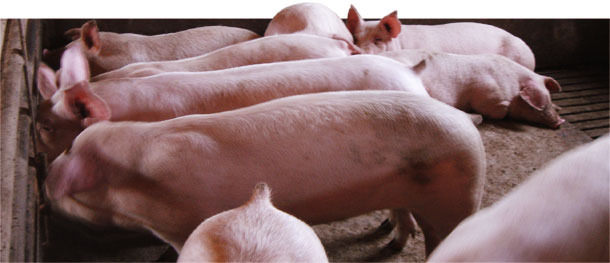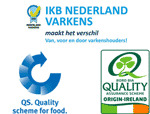Since the publishing, in year 2003, of the Regulation (EC) no. 2160/2003 on the control of salmonella and other zoonotic agents, the EU ordered the obligation of the implementation of specific programmes for the surveillance and control of Salmonella in poultry and pigs. Whilst the programmes for poultry farming were implemented a little later and have obtained very good results, in the case of pigs we are waiting for the reactivation of the aforementioned Regulation and the setting of the EU objectives regarding the reduction of the prevalence. Even though, many countries, and among them the main pig producers, have already moved forward and have been carrying on some kind surveillance and/or control programme.
In the face of this situation, it is obvious that the Spanish swine sector will have to take steps, in the short term, regarding this matter if it does not wish to risk its exports. Many questions are posed in the face of the start of any large-scale initiative regarding the control of salmonellosis. This article summarises the main action strategies, especially at the farm level, followed by the different current salmonellosis surveillance and control programmes in the EU.


Approach of the salmonellosis control progra mmes
The European strategy for the surveillance and control of Salmonella, unlike the one followed for many years in US, based on actions (mainly decontamination) in the abattoir, is mainly based on actions on the farms, although recently, emphasis has also been placed in the abattoirs after the reinforcing of the control of Salmonella on the carcasses (EU Regulation no. 217/2014 of 7 March 2014).
Although in some of the countries the programmes were started by the government, as of today, the majority of them have been an initiative of the pig sector, and they impose some kind of penalties or they follow an incentives policy.
 Penalties: this is the case of Denmark, where an economic penalty of 2% on the value of the carcass is applied for level 2 farms (intermediate seroprevalence) and of between 4% and 8% for level 3 farms (high seroprevalence).
Penalties: this is the case of Denmark, where an economic penalty of 2% on the value of the carcass is applied for level 2 farms (intermediate seroprevalence) and of between 4% and 8% for level 3 farms (high seroprevalence).- Incentives: there are several countries that have created quality assurance schemes, as for instance Germany (QS Qualität und Sicherheit), the United Kingdom (British Quality Assured Pork), Ireland (Bord Bía Quality Assurance Scheme) and The Netherlands (IKB Nederland Varkens).
Basic elements of the control programmes on the farms
In the EU we find two kind of very different situations regarding the levels of the prevalence of the infection on the pig farms, and they determine the goals pursued by the different control programmes. In Sweden, Finland and Norway, the prevalence is very low and their programmes are ruled by an eradication strategy. This strategy cannot be followed in the rest of the European countries, in which the prevalence levels are medium-high. So, the objective of the majority of the European swine salmonellosis surveillance and control programmes is to reduce the infection levels as most as possible.
With regard to the basic items that are a part of the different programmes, and bearing in mind that each of them has its peculiarities, roughly speaking we could summarize them as follows:
1. Acting at two levels: farms and abattoirs
The Danish models estimate that the control programmes focused solely on the farms are insufficient for reducing the contamination levels caused by Salmonella on the carcasses below 1% (Baptista et al. 2011). Once the prevalence on the farms is reduced to a certain level, it will be the moment in which with actions in the abattoirs we would obtain better results in terms of cost-efficacy.
2. Continuous surveillance of the infection and classification on the farms
Given the great seasonal variability of swine salmonellosis, the surveillance actions must be maintained throughout time. This surveillance may be serological (blood samples and/or meat juice), allowing to classify the different farms in different categories and to act on those with a higher infection risk (with a higher seroprevalence).

But currently...
... The United Kingdom has put a stop to the serological monitoring of the animals because it is redefining its control programme.
... in Ireland they do not classify the farms in three categories anymore, but they are assigned a prevalence level.
3. Prioritization of the controls in the fattening stage
Up to now, in the initial stages of all the programmes, the surveillance actions have mainly included the fattening stage, although later, like in the case of the Danish and Irish programmes, the sows' farms have also been included.
4. Implementation of individual control plans on the farms
On the farms with a higher infection level, once the risk factors have been identified (through a detailed checklist), and a bacteriological study of the circulating strains has been carried out, the veterinarian in charge of the farm implements a customised control plan.
Next we present a summary table with the main features of the surveillance actions in the fattening stage of the swine salmonellosis control programmes in Denmark, Ireland, United Kingdom, Germany and The Netherlands. Apart from these countries, in Austria they are carrying out a regional control programme, and in Belgium, France, and recently in Catalonia, we can find several pilot studies. In particular, the Catalan pork cluster INNOVACC is leading a pilot study for the implementation of a voluntary programme for the control of swine salmonellosis that in this moment counts on the involvement of an important number of farms and abattoirs in Catalonia and of some in Aragon. Without a doubt, all these initiatives will provide a good basis for the implementation of the future programmes for the control of Salmonella in these countries.
Table 1. Surveillance actions in the fattening stage of the main swine salmonellosis control programmes in the European Union
| Country | Sampling | Serological monitoring | Classification | |||
| Sample | Number / year |
ELISAs used | Cut-off point* | Regularity | Categories | |
| Denmmark | Meat juice | 60-100¹ | Danish mix ELISA | DO% ≥ 20 | Quarterly (weighting: 3:1:1) | 1 (< 40%) 2 (≥ 40% and < 65%) 3 (≥ 65%) |
| Ireland | Blood | Max. 72 (6/month) | Not specified | DO% ≥ 40 | Quarterly | NO (if ≥ 50% the farm is excluded from the quality assurance scheme) |
| United Kingdom | The control programme has temporarily suspended the serological monitoring (meat juice) on the farms and is awaiting for the passing of new actions | |||||
| Germany | Meat juice (blood) | 60 | Salmotype, Labor Diagnostik Herd Check, IDEXX PrioCheck, Prionics |
DO% ≥ 40 | Quarterly |
1 (≤ 20%) |
| The Netherlands | Blood | 36 | Not specified | DO% ≥ 40 | Quarterly | Similar to the German programme |
*Cut-off point from which a sample is considered positive
1 Depending on the number of animals sent to the abattoir yearly: 60 (< 2,000 pigs); 75 (2,001-5,000 pigs); 100 (> 5,000 pigs)
Finally, as a conclusion, we must mention that in accordance with the previously mentioned Regulation (EC) no. 2160/2003, in the future, the EU will have to define its objectives for the reduction of salmonellosis for each country depending on its starting point. It seems evident that this initial situation will be marked by the results of the European Community reference studies carried out in 2006-2007 (EFSA 2008). It is very probable that the way of reaching these goals is left up to each country depending on its own production structure, among other aspects, but surely, some or all of the general items evaluated here will be borne in mind. The role of the abattoir will be undoubtedly essential for avoiding that the infection reaches the consumer and to guarantee, in this way, the final success of the programmes.


